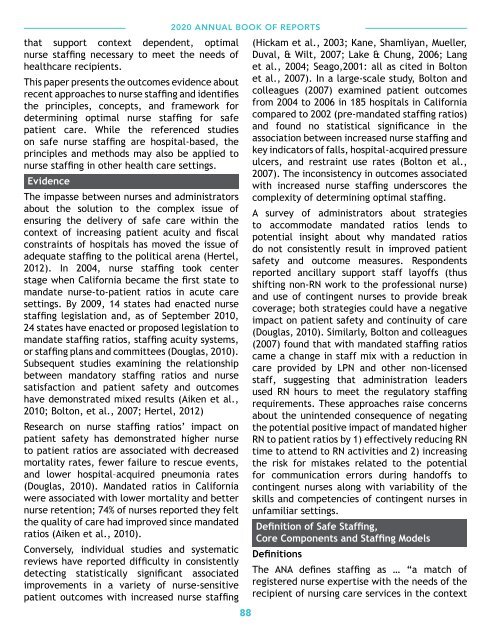ANA-Michigan - 2020 Annual Book of Reports
You also want an ePaper? Increase the reach of your titles
YUMPU automatically turns print PDFs into web optimized ePapers that Google loves.
that support context dependent, optimal<br />
nurse staffing necessary to meet the needs <strong>of</strong><br />
healthcare recipients.<br />
This paper presents the outcomes evidence about<br />
recent approaches to nurse staffing and identifies<br />
the principles, concepts, and framework for<br />
determining optimal nurse staffing for safe<br />
patient care. While the referenced studies<br />
on safe nurse staffing are hospital-based, the<br />
principles and methods may also be applied to<br />
nurse staffing in other health care settings.<br />
Evidence<br />
The impasse between nurses and administrators<br />
about the solution to the complex issue <strong>of</strong><br />
ensuring the delivery <strong>of</strong> safe care within the<br />
context <strong>of</strong> increasing patient acuity and fiscal<br />
constraints <strong>of</strong> hospitals has moved the issue <strong>of</strong><br />
adequate staffing to the political arena (Hertel,<br />
2012). In 2004, nurse staffing took center<br />
stage when California became the first state to<br />
mandate nurse-to-patient ratios in acute care<br />
settings. By 2009, 14 states had enacted nurse<br />
staffing legislation and, as <strong>of</strong> September 2010,<br />
24 states have enacted or proposed legislation to<br />
mandate staffing ratios, staffing acuity systems,<br />
or staffing plans and committees (Douglas, 2010).<br />
Subsequent studies examining the relationship<br />
between mandatory staffing ratios and nurse<br />
satisfaction and patient safety and outcomes<br />
have demonstrated mixed results (Aiken et al.,<br />
2010; Bolton, et al., 2007; Hertel, 2012)<br />
Research on nurse staffing ratios’ impact on<br />
patient safety has demonstrated higher nurse<br />
to patient ratios are associated with decreased<br />
mortality rates, fewer failure to rescue events,<br />
and lower hospital–acquired pneumonia rates<br />
(Douglas, 2010). Mandated ratios in California<br />
were associated with lower mortality and better<br />
nurse retention; 74% <strong>of</strong> nurses reported they felt<br />
the quality <strong>of</strong> care had improved since mandated<br />
ratios (Aiken et al., 2010).<br />
Conversely, individual studies and systematic<br />
reviews have reported difficulty in consistently<br />
detecting statistically significant associated<br />
improvements in a variety <strong>of</strong> nurse-sensitive<br />
patient outcomes with increased nurse staffing<br />
<strong>2020</strong> ANNUAL BOOK OF REPORTS<br />
88<br />
(Hickam et al., 2003; Kane, Shamliyan, Mueller,<br />
Duval, & Wilt, 2007; Lake & Chung, 2006; Lang<br />
et al., 2004; Seago,2001: all as cited in Bolton<br />
et al., 2007). In a large-scale study, Bolton and<br />
colleagues (2007) examined patient outcomes<br />
from 2004 to 2006 in 185 hospitals in California<br />
compared to 2002 (pre-mandated staffing ratios)<br />
and found no statistical significance in the<br />
association between increased nurse staffing and<br />
key indicators <strong>of</strong> falls, hospital-acquired pressure<br />
ulcers, and restraint use rates (Bolton et al.,<br />
2007). The inconsistency in outcomes associated<br />
with increased nurse staffing underscores the<br />
complexity <strong>of</strong> determining optimal staffing.<br />
A survey <strong>of</strong> administrators about strategies<br />
to accommodate mandated ratios lends to<br />
potential insight about why mandated ratios<br />
do not consistently result in improved patient<br />
safety and outcome measures. Respondents<br />
reported ancillary support staff lay<strong>of</strong>fs (thus<br />
shifting non-RN work to the pr<strong>of</strong>essional nurse)<br />
and use <strong>of</strong> contingent nurses to provide break<br />
coverage; both strategies could have a negative<br />
impact on patient safety and continuity <strong>of</strong> care<br />
(Douglas, 2010). Similarly, Bolton and colleagues<br />
(2007) found that with mandated staffing ratios<br />
came a change in staff mix with a reduction in<br />
care provided by LPN and other non-licensed<br />
staff, suggesting that administration leaders<br />
used RN hours to meet the regulatory staffing<br />
requirements. These approaches raise concerns<br />
about the unintended consequence <strong>of</strong> negating<br />
the potential positive impact <strong>of</strong> mandated higher<br />
RN to patient ratios by 1) effectively reducing RN<br />
time to attend to RN activities and 2) increasing<br />
the risk for mistakes related to the potential<br />
for communication errors during hand<strong>of</strong>fs to<br />
contingent nurses along with variability <strong>of</strong> the<br />
skills and competencies <strong>of</strong> contingent nurses in<br />
unfamiliar settings.<br />
Definition <strong>of</strong> Safe Staffing,<br />
Core Components and Staffing Models<br />
Definitions<br />
The <strong>ANA</strong> defines staffing as … “a match <strong>of</strong><br />
registered nurse expertise with the needs <strong>of</strong> the<br />
recipient <strong>of</strong> nursing care services in the context

















